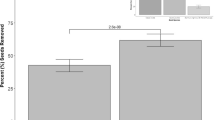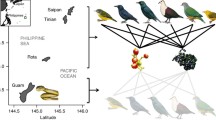Abstract
Invasion of habitats by exotic shrubs is often associated with a decrease in the abundance of native species, particularly trees. This is typically interpreted as evidence for direct resource competition between the invader and native species. However, this may also reflect indirect impacts of the exotic shrubs through harboring high densities of seed predators––known as apparent competition. Here I present data from separate seed predation experiments conducted with two shrub species exotic to North America; Rosa multiflora, an invader of abandoned agricultural land, and Lonicera maackii, an invader of disturbed or secondary forest habitats. Both experiments showed significantly greater risks of seed predation for tree seeds located under shrub canopies when compared to open microhabitats within the same site. These results indicate the potential importance of indirect impacts of exotic species invasions on native biota in addition to the direct impacts that are typically the focus of research.


Similar content being viewed by others
Abbreviations
- DHNC :
-
Douglas-Hart Nature Center
- HMFC :
-
Hutcheson Memorial Forest Center
- L. maackii :
-
Lonicera maackii
- P. leucopus :
-
Peromyscus leucopus
- R. multiflora :
-
Rosa multiflora
References
Bever JD (2003) Soil community feedback and the coexistence of competitors: conceptual frameworks and empirical tests. New Phytol 157:465–473
Byers JE, Reichard S, Randall JM, Parker IM, Smith CS, Lonsdale WM, Atkinson IAE, Seastedt TR, Williamson M, Chornesky E, Hayes D (2002) Directing research to reduce the impacts of nonindigenous species. Conserv Biol 16:630–640
Collins B, Wein GR (1993) Competition between native and immigrant Polygonum congeners. Can J Bot 71:939–945
Crawley MJ (1992) Seed predators and plant population dynamics. In: Fenner M (ed) Seeds: the ecology of regeneration in plant communities, CAB International, Wallingford pp 157–191
D’Antonio CM, Mahall BE (1991) Root profiles and competition between the invasive exotic perennial, Carpobrotus edulis, and two native shrub species in California coastal scrub. Am J Bot 78:885–894
Drickamer LC (1970) Seed preferences in wild caught Peromyscus maniculatus bairdii and Peromyscus leucopus noveboracensis. J Mammal 51:191–194
George LO, Bazzaz FA (1999) The fern understory as an ecological filter: emergence and establishment of canopy-tree seedlings. Ecology 80:833–845
Gorchov DL, Trisel DE (2003) Competitive effects of the invasive shrub, Lonicera maackii (Rupr.) Herder (Caprifoliaceae), on the growth and survival of native tree seedlings. Plant Ecol 166:13–24
Gould AMA, Gorchov DL (2000) Effects of the exotic invasive shrub Lonicera maackii on the survival and fecundity of three species of native annuals. Am Midl Nat 144:36–50
Grime JP (2001) Plant strategies, vegetation processes, and ecosystem properties. John Wiley & Sons, Chichester
Hamilton JG, Holzapfel C, Mahall BE (1999) Coexistence and interference between native perennial grass and non-native annual grasses in California. Oecologia 121:518–526
Herrera CM, Jordano P, Lopez-Soria L, Amat JA (1994) Recruitment of a mast-fruiting, bird-dispersed tree: bridging frugivore activity and seedling establishment. Ecol Monogr 64:315–344
Hindal DF, Wong SM (1988) Potential biocontrol of multifloral rose, Rosa multiflora. Weed Technol 2:122–131
Holl KD (2002) Effects of shrubs on tree seedling establishment in an abandoned tropical pasture. J Ecol 90:179–187
Holt RD (1997) Predation, apparent competition, and the structure of prey communities. Theor Popul Biol 12:197–229
Holt RD, Lawton JH (1994) The ecological consequences of shared natural enemies. Annu Rev Ecol Syst 25:495–520
Hulme PE (1993) Post-dispersal seed predation by small mammals. Symp Zool Soc London 65:269–287
Hulme PE (1996) Natural regeneration of yew (Taxus baccata L.): microsite, seed or herbivore limitation? J Ecol 84:853–861
Hutchinson TF, Vankat JL (1997) Invasibility and effects of Amur honeysuckle in southwestern Ohio forests. Conserv Biol 11:1117–1124
Luken JO, Goessling N (1995) Seedling distribution and potential persistence of the exotic shrub Lonicera maackii in fragmented forests. Am Midl Nat 133:124–130
Luken JO, Thieret JW (1996) Amur honeysuckle, its fall from grace. BioScience 46:18–24
Manson RH, Stiles EW (1998) Links between microhabitat preferences and seed predation by small mammals in old fields. Oikos 82:37–50
Marler MJ, Zabinski CA, Callaway RM (1999) Mycorrhizae indirectly enhance competitive effects of an invasive forb on a native bunchgrass. Ecology 80:1180–1186
McCormick JT, Meiners SJ (2000) Season and distance from forest–old field edge affect seed predation by white-footed mice. Northeast Nat 7:7–16
Meiners SJ, LoGiudice K (2003) Temporal consistency in the spatial pattern of seed predation across a forest–old field edge. Plant Ecol 168:45–55
Meiners SJ, Martinkovic MJ (2002) Survival of and herbivore damage to a cohort of Quercus rubra planted across a forest-old field edge. Am Midl Nat 147:247–256
Meiners SJ, Pickett STA (1999) Changes in community and population responses across a forest-field gradient. Ecography 22:261–267
Myster RW, Pickett STA (1993) Effects of litter, distance, density, and vegetation patch type on postdispersal tree seed predation. Oikos 66:381–388
Parker IM, Simberloff D, Lonsdale WM, Goodell K, Wonham M, Kareiva PM, Williamson MH, Von Holle B, Moyle PB, Byers JE, Goldwasser L (1999) Impact: toward a framework for understanding the ecological effects of invaders. Biol Invasions 1:3–19
Pearson PG (1959) Small mammals and old field succession on the Piedmont of New Jersey. Ecology 40:249–255
Pimentel D, Lach L, Zuninga R, Morrison D (2000) Environmental and economic costs of nonindigenous species in the United States. BioScience 50:53–65
Robertson DJ, Robertson MC, Tague T (1994) Colonization dynamics of four exotic plants in a northern Piedmont natural area. Bull Torrey Bot Club 121:107–118
Sessions L, Kelly D (2002) Predator-mediated apparent competition between an introduced grass, Agrostis capillaris, and a native fern, Botrychium australe (Ophioglossaceae), in New Zealand. Oikos 96:102–109
Veech JA (2000) Predator-mediated interactions among the seeds of desert plants. Oecologia 124:402–407
Woods KD (1993) Effects of invasion by Lonicera tartarica L. on herbs and tree seedlings in four New England forests. Am Midl Nat 130:62–74
Acknowledgements
I thank G. M. Groves and P. Forsythe for assistance in the field, T. A. Nelson for providing data on the seed predator assemblage at DHNC, the 2001 Plant Ecology class at EIU for conducting the species removal, and L. C. Miramontes, B. E. Wachholder, and K. A. Yurkonis for comments on previous versions of this manuscript. Work at HMFC was supported by a Summer Research Fellowship from Rutgers University. Work at DHNC was supported by Wildlife Preservation Fund Grant #02–002W from the Illinois Department of Natural Resources and a Redden Fund grant from the Eastern Illinois University Foundation.
Author information
Authors and Affiliations
Corresponding author
Rights and permissions
About this article
Cite this article
Meiners, S.J. Apparent competition: an impact of exotic shrub invasion on tree regeneration. Biol Invasions 9, 849–855 (2007). https://doi.org/10.1007/s10530-006-9086-5
Received:
Accepted:
Published:
Issue Date:
DOI: https://doi.org/10.1007/s10530-006-9086-5




